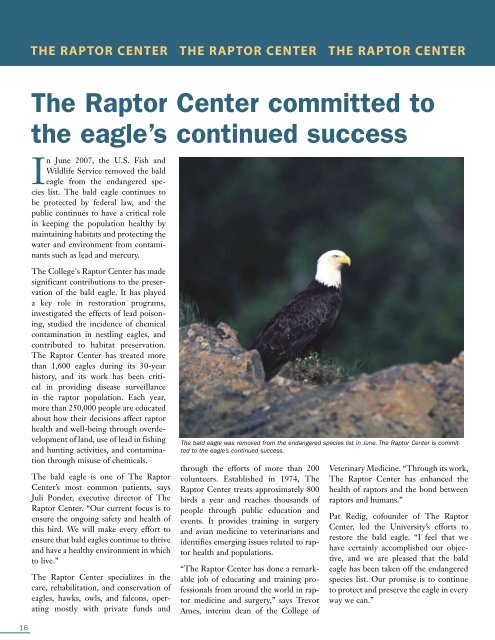The Raptor Center The Raptor Center The Raptor CenterThe Raptor Center committed tothe eagle’s continued successIn June 2007, the U.S. Fish andWildlife Service removed the baldeagle from the endangered specieslist. The bald eagle continues tobe protected by federal law, and thepublic continues to have a critical rolein keeping the population healthy bymaintaining habitats and protecting thewater and environment from contaminantssuch as lead and mercury.The <strong>College</strong>'s Raptor Center has madesignificant contributions to the preservation<strong>of</strong> the bald eagle. It has playeda key role in restoration programs,investigated the effects <strong>of</strong> lead poisoning,studied the incidence <strong>of</strong> chemicalcontamination in nestling eagles, andcontributed to habitat preservation.The Raptor Center has treated morethan 1,600 eagles during its 30-yearhistory, and its work has been criticalin providing disease surveillancein the raptor population. Each year,more than 250,000 people are educatedabout how their decisions affect raptorhealth and well-being through overdevelopment<strong>of</strong> land, use <strong>of</strong> lead in fishingand hunting activities, and contaminationthrough misuse <strong>of</strong> chemicals.The bald eagle is one <strong>of</strong> The RaptorCenter’s most common patients, saysJuli Ponder, executive director <strong>of</strong> TheRaptor Center. “Our current focus is toensure the ongoing safety and health <strong>of</strong>this bird. We will make every effort toensure that bald eagles continue to thriveand have a healthy environment in whichto live.”The Raptor Center specializes in thecare, rehabilitation, and conservation <strong>of</strong>eagles, hawks, owls, and falcons, operatingmostly with private funds andThe bald eagle was removed from the endangered species list in June. The Raptor Center is committedto the eagle’s continued success.through the efforts <strong>of</strong> more than 200volunteers. Established in 1974, TheRaptor Center treats approximately 800birds a year and reaches thousands <strong>of</strong>people through public education andevents. It provides training in surgeryand avian medicine to veterinarians andidentifies emerging issues related to raptorhealth and populations.“The Raptor Center has done a remarkablejob <strong>of</strong> educating and training pr<strong>of</strong>essionalsfrom around the world in raptormedicine and surgery,” says TrevorAmes, interim dean <strong>of</strong> the <strong>College</strong> <strong>of</strong><strong>Veterinary</strong> <strong>Medicine</strong>. “Through its work,The Raptor Center has enhanced thehealth <strong>of</strong> raptors and the bond betweenraptors and humans.”Pat Redig, c<strong>of</strong>ounder <strong>of</strong> The RaptorCenter, led the <strong>University</strong>’s efforts torestore the bald eagle. “I feel that wehave certainly accomplished our objective,and we are pleased that the baldeagle has been taken <strong>of</strong>f the endangeredspecies list. Our promise is to continueto protect and preserve the eagle in everyway we can.”16
faculty and staff newsfaculty and staff newsJaime Modiano joins <strong>College</strong>as Al and June PerlmanEndowed Oncology ChairJaime Modiano, V.M.D., Ph.D., joined the <strong>College</strong> in July as the Al and June PerlmanEndowed Oncology Chair and director <strong>of</strong> the <strong>Veterinary</strong> Medical Center’s AnimalCancer Center. Modiano leads the <strong>College</strong>’s comparative cancer research program,which ultimately seeks to develop effective strategies for cancer prevention and treatmentby integrating knowledge gained from studies <strong>of</strong> cancer in people and animals.“Comparative medicine is an important part <strong>of</strong> researchefforts at the <strong>University</strong> <strong>of</strong> <strong>Minnesota</strong>,” says RobertWashabau, chair <strong>of</strong> the <strong>Veterinary</strong> Clinical SciencesDepartment. “The research directed by Dr. Modianowill support that program by benefiting both animals andhumans.”“I am extremely pleased that Dr. Modiano has joined ourfaculty,” says Trevor Ames, interim dean. “He has the experience,commitment, and know-how to help the <strong>College</strong>become a world leader in comparative cancer research.”Jaime Modiano Cancer accounts for almost half <strong>of</strong> the deaths <strong>of</strong> pets over10 years <strong>of</strong> age, and each case requires individual treatment.“Dr. Modiano’s research will expand the types <strong>of</strong> treatments available to effectivelytreat cancer through his discoveries <strong>of</strong> new knowledge,” Ames adds.Modiano was previously associate pr<strong>of</strong>essor <strong>of</strong> immunology and full member <strong>of</strong> theCancer Center at the <strong>University</strong> <strong>of</strong> Colorado Health Sciences Center and seniorscientist at the AMC Cancer Center in Denver, Colorado. His research focuses oncontrol <strong>of</strong> activation and signaling in cells <strong>of</strong> the immune system, the genetic basis<strong>of</strong> cancer, and cancer gene therapy and immunotherapy.Modiano completed his veterinary and Ph.D. training in immunology at the<strong>University</strong> <strong>of</strong> Pennsylvania, followed by a residency in veterinary clinical pathologyat Colorado State <strong>University</strong> and a post-doctoral fellowship at the National JewishCenter for Immunology and Respiratory <strong>Medicine</strong> in Denver, Colo. He was assistantpr<strong>of</strong>essor <strong>of</strong> <strong>Veterinary</strong> Pathobiology at Texas A&M <strong>University</strong> from 1995 to1999 and joined the AMC Cancer Center in 1999. He has co-authored more than150 scientific manuscripts, presentations, and book chapters on various aspects <strong>of</strong>immunology, cancer cell biology, the genetic basis <strong>of</strong> cancer, and applications <strong>of</strong>gene therapy.“Recruitment <strong>of</strong> Dr. Modiano to the <strong>University</strong> <strong>of</strong> <strong>Minnesota</strong> builds a bridge betweenthe Medical School’s Cancer Center and the <strong>College</strong> <strong>of</strong> <strong>Veterinary</strong> <strong>Medicine</strong>, providingthe critical link needed in the area <strong>of</strong> comparative cancer research that willbenefit both animals and humans,” says Tucker LeBien, associate director <strong>of</strong> basicresearch at the <strong>University</strong> <strong>of</strong> <strong>Minnesota</strong> Cancer Center.New advancementmodel mergesdevelopment, alumniaffairs, continuingeducation, andcommunicationsTo build and strengthen relationshipswith the diverse constituenciesthat provide support, the <strong>College</strong><strong>of</strong> <strong>Veterinary</strong> <strong>Medicine</strong> has adoptedan advancement model combiningdevelopment, alumni affairs, continuingeducation, and communicationsstaff. Sharon Staton has joined the<strong>College</strong> as director <strong>of</strong> advancement,a new position that provides strategicleadership for the integrated team.Staton works with the <strong>University</strong><strong>of</strong> <strong>Minnesota</strong> Foundation to engagethe resources <strong>of</strong> the private sectorto build and sustain excellence at the<strong>College</strong>.“I am very excited to be workingfor the <strong>College</strong> to enhance relationshipswith alumni, friends, corporations,and foundations and increasephilanthropic support to sustainour research, teaching, and serviceefforts,” she says.Brian T. Graves joined the advancementteam in January as communicationsmanager. His backgroundincludes the development and execution<strong>of</strong> integrated communications,sales, and marketing plans and strategicpartnerships in support <strong>of</strong> publicrelations, marketing, and fund-raisinginitiatives. He earned his master’sdegree in journalism from the<strong>University</strong> <strong>of</strong> Iowa and his bachelor’sdegree in public relations from the<strong>University</strong> <strong>of</strong> Northern Iowa.17
















